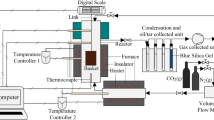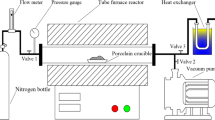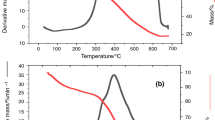Abstract
Integrated pelletization of torrefied biomass is used to improve the energy density, handling, and combustion properties of produced solid biofuels. The goal of this study was to use a mixture of corn cob and khat stem through a combination of torrefaction and co-pelletization processes. The response surface methodology was used to investigate the optimization of co-pelletization parameters. Torrefied biomass blending ratio and particle size were chosen as independent factors. The dependent variables were heating value, bulk density, and durability of torrefied mixed pellets. According to the analysis of variance, the biomass blending ratio and particle size were discovered to be significant study parameters that influenced the heating value, bulk density, and durability. The interaction effects of the parameters chosen are well fit by the second-order quadratic model equation. For a maximum heating value of 26.4 MJ/kg, a bulk density of 808 kg/m3, and durability of 94.48%, the optimum values of the influencing parameters were 0.33 g/g % mixing ratio and 0.5-mm particle size. The physicochemical properties of the mixed torrefied pellet obtained under optimal conditions were compared to those of torrefied corn cob and khat stem. Pelletization of torrefied bio-residues had a significant effect on all of the properties studied, according to the findings. The torrefied pellet produced had good properties in terms of heating value, bulk density, and durability.







Similar content being viewed by others
References
Venkatramanan V, Prasad SSS, Singh A, Prasad R (2015) “Assessment of bioenergy generation potential of agricultural crop residues in India,”7(July): 53–58, 2015, https://doi.org/10.5897/JETR2015.0545
Venkatramanan V, Shah S, Prasad S, Singh A (2021) and & Ram Prasad, “Assessment of bioenergy generation potential of agricultural crop residues in India.” Circ Econ Sustain. https://doi.org/10.1007/s43615-021-00072-7
Long H, Li X, Wang H, Jia J (2021) Biomass resources and their bioenergy potential estimation: a review. Front Energy Res 9(July):1–10. https://doi.org/10.3389/fenrg.2021.684234
Karkania V, Fanara E, Zabaniotou A (2012) Review of sustainable biomass pellets production – a study for agricultural residues pellets ’ market in Greece. Renew Sustain Energy Rev 16(3):1426–1436. https://doi.org/10.1016/j.rser.2011.11.028
Jesus H et al., (2020) “Pelletization of eucalyptus wood and coffee growing wastes : strategies for biomass valorization and sustainable bioenergy production,” 149: 128–140, https://doi.org/10.1016/j.renene.2019.12.015.
Anukam A, Berghel J, Henrikson G, Frodeson S, Ståhl M (2021) A review of the mechanism of bonding in densified biomass pellets. Renew Sustain Energy Rev 148(August 2020):111249. https://doi.org/10.1016/j.rser.2021.111249
Cao L et al (2015) Complementary effects of torrefaction and co-pelletization: energy consumption and characteristics of pellets. Bioresour Technol 185:254–262. https://doi.org/10.1016/j.biortech.2015.02.045
Song X, Yang Y, Zhang M, Zhang K, Wang D (2018) Ultrasonic pelleting of torrefied lignocellulosic biomass for bioenergy production. Renew Energy 129:56–62. https://doi.org/10.1016/j.renene.2018.05.084
Martín-Pascual J, Jódar J, Rodríguez ML, Zamorano M (2020) Determination of the optimal operative conditions for the torrefaction of olive waste biomass. Sustain 12(16):1–11. https://doi.org/10.3390/SU12166411
Stelte et al (2011) Pelletizing properties of torrefied spruce. Biomass Bioenerg 35(11):4690–4698. https://doi.org/10.1016/j.biombioe.2011.09.025
Gebregziabher B, Kassahun SK, Kiflie Z (2021) Statistical optimization of mixed peanut shell and Khat (Catha edulis) stem carbonization process for molasses enhanced cold and low-pressure pelletization. Biomass Convers Biorefinery. https://doi.org/10.1007/s13399-021-01446-5
Y. Tadesse, S. Kebede, and K. Zebene, (2021) “Effects of operational parameters on torrefaction performance of coffee husk and cotton stalk mixed biomass : a surface response methodology approach,” Biomass Convers. Biorefinery, no. 0123456789, https://doi.org/10.1007/s13399-021-01649-w
Cui X, Yang J, Wang Z, Shi X (2021) Better use of bioenergy: a critical review of co-pelletizing for biofuel manufacturing. Carbon Capture Sci Technol. 1(October):100005. https://doi.org/10.1016/j.ccst.2021.100005
van der Stelt MJC, Gerhauser H, Kiel JHA, Ptasinski KJ (2011) Biomass upgrading by torrefaction for the production of biofuels: a review. Biomass Bioenerg 35(9):3748–3762. https://doi.org/10.1016/j.biombioe.2011.06.023
Berhanu M, Jabasingh SA, Kifil Zebene (2017) Expanding sustenance in Ethiopia based on renewable energy resources – a comprehensive review. Renew Sustain Energy Rev 75(November 2016):1035–1045. https://doi.org/10.1016/j.rser.2016.11.082
Seboka Y, Getahun MA, Haile-meskel Y (2009). Biomass energy for cement prodution: opportunities in ethiopia. United Nations Development Programm p 77. Addis ababa, Ethiopia
SeyoumTaffesse A, Dorosh P, Gemessa SA (2013) Crop production in Ethiopia: regional patterns and trends. Food Agric Ethiop Prog Policy Challenges 9780812208:53–83. https://doi.org/10.9783/9780812208610.53
Oliy GB, Muleta DT (2020) Characterization and determination of briquette fuel prepared from five variety of corn cob. Int J Sustain Green Energy 9(3):59–64. https://doi.org/10.11648/j.ijrse.20200903.11
Siyal AA et al (2021) Co-pelletization of sewage sludge, furfural residue and corn stalk: characteristics and quality analysis of pellets. Biomass and Bioenergy 150(January):106121. https://doi.org/10.1016/j.biombioe.2021.106121
Thapa S, Engelken R (2020) Optimization of pelleting parameters for producing composite pellets using agricultural and agro-processing wastes by Taguchi-Grey relational analysis. Carbon Resour. Convers. 3(October 2019):104–111. https://doi.org/10.1016/j.crcon.2020.05.001
Liu Z, Liu X, Fei B, Jiang Z, Cai Z, Yu Y (2013) The properties of pellets from mixing bamboo and rice straw. Renew Energy 55:1–5. https://doi.org/10.1016/j.renene.2012.12.014
Stelte W, Holm JK, Sanadi AR, Barsberg S, Ahrenfeldt J, Henriksen UB (2011) Fuel pellets from biomass: the importance of the pelletizing pressure and its dependency on the processing conditions. Fuel 90(11):3285–3290. https://doi.org/10.1016/j.fuel.2011.05.011
Li H, Liu X, Legros R, Bi XT, Lim CJ, Sokhansanj S (2012) Pelletizing of Colombian agro-industrial biomasses with crude glycerol. Appl Energy 93:680–685. https://doi.org/10.1016/j.apenergy.2012.01.002
ASTM, (2007) “Standard test methods for direct moisture content measurement of wood and wood-base materials,” in ASTM Internationa, vol. 92, no. December, West Conshohocken: ASTM International, pp. 1–6
ASTM E872–82(2019), “Standard test method for volatile matter in the analysis of particulate wood fuels.”,” https//www.astm.org/Standards/E872.htm (accessed Jul. 27, 2021)., https://doi.org/10.7176/cer/12-1-03.
Sluiter A, Hames B, Ruiz R, Scarlata C, Sluiter J, Templeton D (2008). Determination of ash in biomass. NREL laboratory analytical procedure (LAP), National Renewable Energy Laboratory, Golden, CO
Krotz L, Giazzi G (2017) “Elemental Analysis : CHNS/O characterization of carbon black compliance with ASTM D5373 Method,” thermoscientific
Chao CYH, Kwong PCW, Wang JH, Cheung CW, Kendall G (2008) Co- W ring coal with rice husk and bamboo and the impact on particulate matters and associated polycyclic aromatic hydrocarbon emissions. Bioresour Technol. 99(99):83–93. https://doi.org/10.1016/j.biortech.2006.11.051
Miafo A-PT, Koubala BB, Kansci G, Saha BUF, Fokou E (2015) Optimizing the extraction of dietary fibers from sorghum bran using response surface methodology. J Food Process 2015:1–8. https://doi.org/10.1155/2015/609703
Ajimotokan HA, Ehindero AO, Ajao KS, Adeleke AA, Ikubanni PP, Shuaib-Babata YL (2009) “Combustion characteristics of fuel briquettes made from charcoal particles and sawdust agglomerates,” Sci African, 6, https://doi.org/10.1016/j.sciaf.2019.e00202
Kizuka R, Ishii K, Sato M, Fujiyama A (2019) Characteristics of wood pellets mixed with torrefied rice straw as a biomass fuel. Int J Energy Environ Eng 10(3):357–365. https://doi.org/10.1007/s40095-019-0305-0
Marrugo G, Valdés CF, Gómez C, Chejne F (2018) Pelletizing of Colombian agro-industrial biomasses with crude glycerol. Renew Energy 134:558–568. https://doi.org/10.1016/j.renene.2018.11.004
Telmo C, Lousada J (2011) Heating values of wood pellets from different species. Biomass Bioenerg 35(7):2634–2639. https://doi.org/10.1016/j.biombioe.2011.02.043
Pradhan P, Mahajani SM, Arora A (2018) Production and utilization of fuel pellets from biomass : A review. Fuel Process Technol 181(August):215–232. https://doi.org/10.1016/j.fuproc.2018.09.021
Rudolfsson M, Stelte W, Lestander TA (2015) Process optimization of combined biomass torrefaction and pelletization for fuel pellet production – a parametric study. Appl Energy 140:378–384. https://doi.org/10.1016/j.apenergy.2014.11.041
Stelte W, Dahl J, Nielsen NPK, Danish HOH (2012) “Densification concepts for torrefied biomass,” IEA Bioenergy
Stelte W, Holm JK, Sanadi AR, Barsberg S, Ahrenfeldt J, Henriksen UB (2011) Fuel pellets from biomass : the importance of the pelletizing pressure and its dependency on the processing conditions. Fuel 90(11):3285–3290. https://doi.org/10.1016/j.fuel.2011.05.011
Pirraglia A, Gonzalez R, Saloni D, Wright J, Denig J (2012) Fuel properties and suitability of Eucalyptus benthamii and Eucalyptus macarthurii for torrefied wood and pelletS. Fuel J 7(1998):217–235
Peng JH, Bi XT, Sokhansanj S, Lim CJ (2013) Torrefaction and densification of different species of softwood residues. Fuel 111:411–421. https://doi.org/10.1016/j.fuel.2013.04.048
Kleinschmidt CP (2011) “Overview of international developments in torrefaction,” 2011 Cent. Eur. Biomass Conf. Torrefaction Work., p. 9
Acknowledgements
The authors acknowledge all support from the department of Chemical Engineering, College of Biological and Chemical Engineering, Addis Ababa Science and Technology University.
Author information
Authors and Affiliations
Corresponding author
Additional information
Publisher's note
Springer Nature remains neutral with regard to jurisdictional claims in published maps and institutional affiliations.
Rights and permissions
About this article
Cite this article
Jifara, B., Diriba, M. & Mengesha, A. Pelletization of mixed torrefied corn cob and khat stem to enhance the physicochemical and thermal properties of solid biofuel and parametric optimization. Biomass Conv. Bioref. (2022). https://doi.org/10.1007/s13399-022-02627-6
Received:
Revised:
Accepted:
Published:
DOI: https://doi.org/10.1007/s13399-022-02627-6




